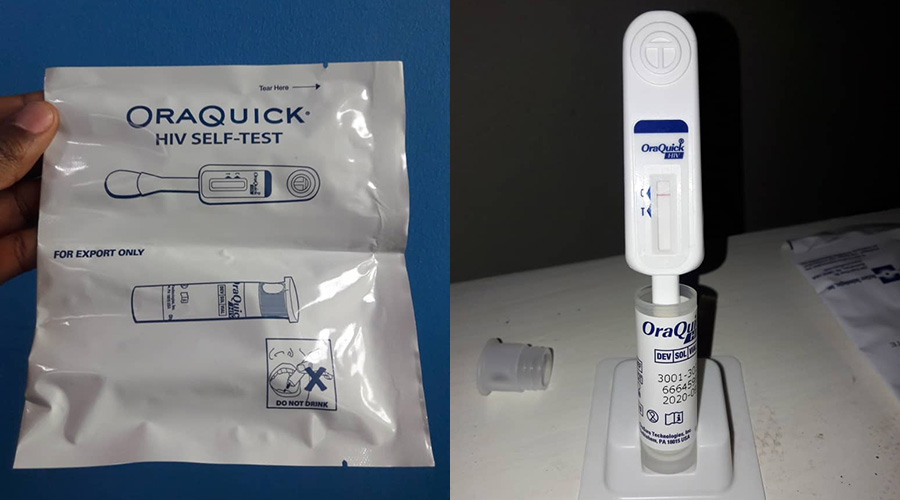

People around the world are increasingly applying various forms of technologies in their lives.
In the health sector, for instance, many diseases can be easily detected using self-testing mechanisms, among them HIV which can be self-tested using Oraquick.
Currently, the HIV self-testing kit is sold in 20 pharmacies in Kigali authorised by the Ministry of Health but will soon be available across the country.
Ernest (not real name) from Kicukiro District has so far conducted HIV tests twice throughout his life.
The first time was during a campaign against HIV in his high school, ten years ago, while the second time was when he conducted the test himself using the Oraquick.
"Before it became available, whenever I thought of going to the health center for an HIV test I would return before even reaching there for fear of meeting people I knew, or even my reaction in front of people if I found I was HIV positive,” he says.
At the end of 2018, he got an Oraquick from his friend which he used to know his actual status.
"I went into my room, opened it and tested myself using oral fluid, with the help of the package guidelines. On the insert, there is a number to call in case one needs any help or information. It is good because it offers privacy,” he said.
Ernest however, said it would be better if the price decreases so as to be more accessible to the people who cannot afford it.
"If the cost is reduced then more people would get access it. However, Rwf5,000 is not affordable for many people,” he said.
The recommended price by the Ministry of Health (MINISANTE) is Rwf 4,000. The conventional HIV tests however is offered freely.
Sabin Nzanzimana, the Division Manager of HIV/AIDS and STIs Diseases Division at Rwanda Biomedical Centre (RBC) said some years ago people in the countryside who sought to establish their HIV statuses were obliged to travel to Kigali for testing.The service was later decentralised to district hospitals and eventually health centres.
Now, Nzanzimana says, Rwanda has rolled out a self-testing mechanism, which is suitable for even the busiest persons.
But how does it work?
The author attempted to establish the accessibility and practicability of the HIV self-testing mechanism.Last week, she went to Mediasol pharmacy in Remera and ordered for Oraquick.
After about five minutes, Belinda Umutoni, one of the employees at the pharmacy came in. She explained how to use the test.
Many of their customers are busy workers, who don’t even have the time to listen to counselling, so they don’t offer counselling services most of the times, Umutoni added.
"They don’t have time for counselling. But if someone shows interest in it and they have time, we do it,” she said.
DrNsanzimana said they have already distributed about 5000 Oraquick tests in some public and private institutions and 10,000 more will be distributed in 2019.
"We have a full report about all these people who used these tests. No one among them has ever experienced any mental problem like depression or committed suicide. On the other hand, they expressed gratitude on knowing their status in secret,” he said.
He says that the old way of counseling people for HIV testing was badly designed as it fueled fear in people seeking for the service. A person had to undergo three counselling sessions before being tested, which discouraged some people from continuing with the tests due to fear.
"We designed another method of counselling, which is very brief. We have trained the pharmacists in order to help their clients,” he said.
Dr Placidie Umugwaneza, the Director of HIV Prevention Unit at RBC, said that the HIV self-testing kit is also suited for people who are reluctant to go with their spouses for testing.
"In prevention of mother to child HIV transmission, we advise pregnant women to come with their husbands. However, some refuse to come completely for various reasons. We think it will be helpful to send them Oraquick tests so that we know their statuses and be able to prevent their babies from being infected,” she said.
How to use it
One is required to spend at least 15 minutes without drinking or eating anything before carrying out the test.
The package contains instructions on how the test is done and caters for English, French and Kinyarwanda speakers.
The kit also has a bottle that contains fluid used during the test and must be placed on a leveled surface. A is taken between the gum and the lips and then deposited in the bottle.
The results can be ready in 20 minutes, and not later than 40 minutes. If the results are positive it will reveal two red horizontal lines before the letter C (Control) and letter T (Test), written on the kit.
The test if negative will reveal one red horizontal line in front of the letter C. It is neutral if nothing before these two letters shows up, or if there is a long red vertical line.
Dr Nsanzimana said if a person finds his/her result positive, they can call 114 to request for more support, and that they are free to choose the health facilities they want for treatment and further help.
The HIV prevalence in Rwanda has been stable since 2005 and remains at 3 percent among adults aged 15-49 (4% among women and 2% among men).
The HIV prevalence is highest in the City of Kigali, at 6.3 percent and is relatively uniform throughout the other provinces (2 percent to 3 percent).
editor@newtimesrwanda.com


